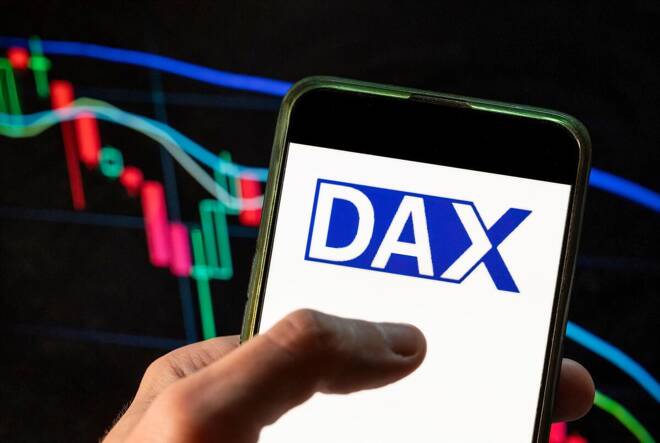Advertisement
Advertisement
DAX Index Today: Political Shifts and ECB Speeches in Focus
By:
Key Points:
- The DAX slid by 0.34% on Monday (June 10), ending the session at 18,495.
- News of a snap French General Election impacted buyer demand for euro area-listed stocks.
- ECB commentary warrants investor attention on Tuesday (June 11), with Chief Economist Philip Lane on the calendar to speak.
The Overview of the DAX Performance
On Monday (June 10), the DAX slid by 0.34%. Following a 0.51% decline on Friday (June 7), the DAX ended the session at 18,495.
Macron Fueled Political Uncertainty with Snap General Election
On Monday, investor hopes of a pickup in economic activity across the Eurozone waned. French President Emmanuel Macron responded to the European election results over the weekend, calling for a snap French General Election.
Concerns about a political shift to the far right impacted investor expectations of multiple 2024 ECB rate cuts. A change in the political landscape could force the ECB to hit the pause button on further interest rate cuts to assess the possible effects of a far-right victory in France.
The CAC 40 dragged the broader European equity markets into negative territory.
There were no economic indicators from Germany, the Eurozone, or the US to influence market risk sentiment.
The US equity markets had a relatively non-eventful day as the US CPI Report and FOMC interest rate decision loomed. On Monday, the Dow rose by 0.18%. The S&P 500 and the Nasdaq Composite Index advanced by 0.28% and 0.26%, respectively.
The Monday Market Movers
On Monday, German banks tracked French banks deep into negative territory. Commerzbank and Deutsche Bank saw losses of 1.48% and 0.10%, respectively.
Retail stocks also trended lower. Adidas and Zalando SE ended the session down 0.56% and 0.60%, respectively.
Additionally, tech stocks Infineon Technologies and SAP saw losses of 0.78% and 0.30%, respectively.
However, auto stocks had a mixed session. Daimler Truck Holding declined by 0.91%, with Volkswagen falling by 0.22%. Mercedes Benz Group gained 0.63%, with Porsche advancing by 0.26%. BMW ended the session up 0.13%.
ECB Commentary in Focus Amidst Political Uncertainty and Sticky Inflation
ECB Chief Economist Philip Lane is on the calendar to speak on Tuesday (June 11).
After cutting interest rates on Thursday (June 6), investors should consider views on inflation, the economic outlook, and the ECB interest rate trajectory. Moreover, investors should monitor French General Election chatter and possible influences on the ECB rate path.
US Business Confidence in Focus as the Fed Rate Decision Looms
Later in the session on Tuesday, the NFIB Business Optimism Index will garner investor interest.
A higher-than-expected NFIB Business Optimism Index could reduce investor bets on multiple 2024 Fed rate cuts. Upward trends in business optimism could signal a pickup in business investment and job creation. Tighter labor market conditions may increase wages and disposable income. Higher disposable income could fuel consumer spending and demand-driven inflation.
While the numbers will influence, the US futures need monitoring as the US CPI Report and Fed interest rate decision loom.
On Wednesday (June 12), higher-than-expected US inflation numbers and more hawkish FOMC Economic Projections could impact buyer demand for DAX-listed stocks.
Near-Term Outlook
Near-term trends for the DAX will hinge on French politics, ECB commentary, the US CPI Report, and the Fed. ECB concerns about the French General Election, higher-than-expected US inflation numbers, and a hawkish Fed could bring sub-18,000 into play.
On the Futures markets, the DAX was up 4 points, while the Nasdaq mini was down 20 points.
DAX Technical Indicators
Daily Chart
The DAX held above the 50-day and 200-day EMAs, sending bullish price signals.
A DAX breakout from the 18,500 level would support a move to the 18,650 handle. A return to 18,650 could give the bulls a run at 18,800.
ECB commentary, US business optimism numbers, and euro area politics need consideration.
Conversely, a DAX fall through the 50-day EMA could signal a drop below 18,250. A break below 18,250 would give the bears a run at 18,000.
The 14-day RSI at 49.33 suggests a fall below 18,250 before entering oversold territory.
4-Hourly Chart
The DAX remained below the 50-day EMA while hovering above the 200-day EMA, affirming the bearish near-term but bullish longer-term price signals.
A DAX move through the 50-day EMA could bring the 18,650 handle into play. A breakout from 18,650 could support a move toward 18,800.
However, a DAX drop below the 18,400 handle may give the bears a run at the 200-day EMA.
The 14-period 4-hour RSI at 46.06 suggests a DAX drop to the 200-day EMA before entering oversold territory.
About the Author
Bob Masonauthor
With over 28 years of experience in the financial industry, Bob has worked with various global rating agencies and multinational banks. Currently he is covering currencies, commodities, alternative asset classes and global equities, focusing mostly on European and Asian markets.
Latest news and analysis
Advertisement
